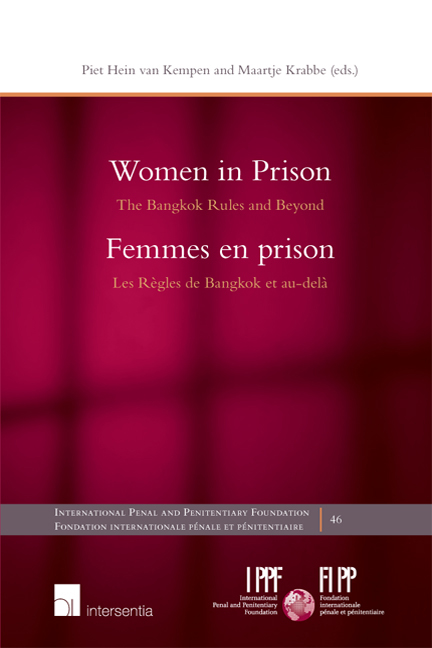Book contents
- Frontmatter
- Foreword
- Avant-propos
- Acknowledgements
- Remerciements
- Contents
- Part I Introductory Synthesis and Analyses: 1ÈRE Partie Synthèse ET Analyses Introductives
- Part II Themes: 2ÈME Partie Thèmes
- Part III National Reports: 3ÈME Partie Rapports Nationaux
- Women in prison in Argentina
- Women in prison in Australia
- Women in prison in Austria
- Women in prison in Brazil
- Women in prison in England and Wales
- Women in prison in Finland
- Femmes en prison en France
- Women in prison in Germany
- Women in prison in Greece
- Women in prison in Ireland
- Femmes en prison en Italie
- Women in prison in the Netherlands
- Women in prison in New Zealand
- Women in prison in Poland
- Women in prison in Portugal
- Women in prison in Russia
- Women in prison in South Africa
- Women in prison in Spain: their criminological and social invisibility
- Femmes en prison en Suisse: la situation des femmes prévenues et condamnées
- Women in prison in Taiwan
- Women in prison in Thailand: implementation of the UN Bangkok Rules in the Thai criminal justice system
- Femmes en prison en Turquie
- Women in prison in the USA
- Appendix The Bangkok Rules: Annexe Règles De Bangkok
- The International Penal and Penitentiary Foundation: History and Purpose
Women in prison in Brazil
from Part III - National Reports: 3ÈME Partie Rapports Nationaux
Published online by Cambridge University Press: 25 September 2018
- Frontmatter
- Foreword
- Avant-propos
- Acknowledgements
- Remerciements
- Contents
- Part I Introductory Synthesis and Analyses: 1ÈRE Partie Synthèse ET Analyses Introductives
- Part II Themes: 2ÈME Partie Thèmes
- Part III National Reports: 3ÈME Partie Rapports Nationaux
- Women in prison in Argentina
- Women in prison in Australia
- Women in prison in Austria
- Women in prison in Brazil
- Women in prison in England and Wales
- Women in prison in Finland
- Femmes en prison en France
- Women in prison in Germany
- Women in prison in Greece
- Women in prison in Ireland
- Femmes en prison en Italie
- Women in prison in the Netherlands
- Women in prison in New Zealand
- Women in prison in Poland
- Women in prison in Portugal
- Women in prison in Russia
- Women in prison in South Africa
- Women in prison in Spain: their criminological and social invisibility
- Femmes en prison en Suisse: la situation des femmes prévenues et condamnées
- Women in prison in Taiwan
- Women in prison in Thailand: implementation of the UN Bangkok Rules in the Thai criminal justice system
- Femmes en prison en Turquie
- Women in prison in the USA
- Appendix The Bangkok Rules: Annexe Règles De Bangkok
- The International Penal and Penitentiary Foundation: History and Purpose
Summary
INTRODUCTION
The words of Norberto Bobbio aptly translate the question that will permeate this analysis of imprisonment of women in Brazil:
“[T]he problem that we have before us is not philosophical, but legal, and, in a broader sense, political. It is not a question of knowing what and how many those rights are, what is their nature and foundation, whether they are natural or historic, absolute or relative rights, but instead, what is the safest way to guarantee them, so that, solemn declarations notwithstanding, they are not continuously violated.”
At the international level Brazil is in fact a signatory to various both declaratory and conventional instruments for promoting and protecting human rights, which are applicable to incarcerated women. Domestically, accompanying those international norms, the Federal Constitution of 1988 chose as one of the foundations of the Brazilian State respect for human dignity (Federal Constitution (CF), Article 1, item III), which is the basis for the entire international system for protecting those rights. Other constitutional dispositions, as well as a series of infra-constitutional standard-setting instruments, establish rights for persons deprived of liberty, obviously applicable to women, as well as certain mechanisms for exercising them. It may thus be seen that there is a minimum legislative framework in Brazil, which certainly needs improvement, especially regarding the condition of incarcerated women, and which needs to be accompanied by a political choice that seeks to implement effective instruments capable of guaranteeing such protection in practice. Even so, a positive evolution in this regard can be observed.
The perception and understanding of female criminality by Brazilian institutions has evolved and been modified. The first female prison units in Brazil began during the 1930s and 1940s, and were the Female Institute for Social Re-adaptation in Porto Alegre, Rio Grande do Sul, begun in 1937, the Penitentiary for Women of São Paulo and the Women's Penitentiary of Bangu in the municipality of Rio Janeiro, inaugurated in 1942.
Contrary to the usual practice, the institutions mentioned above were not initially administered directly by the penitentiary system, but instead by a Catholic religious order, the Sisters of the Good Shepherd of Angers. Their mission was the moral cure of “fallen” women, those in situations of abandonment, prostitution and conflict with the law.
- Type
- Chapter
- Information
- Women in PrisonThe Bangkok Rules and Beyond, pp. 273 - 294Publisher: IntersentiaPrint publication year: 2017



